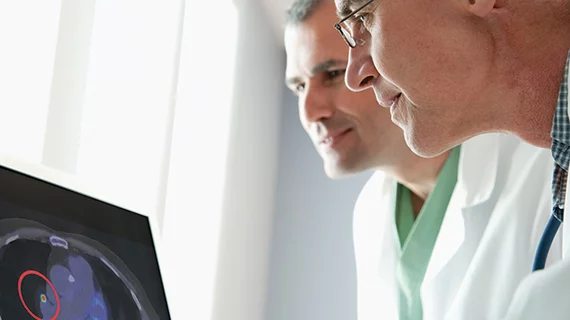Dual-energy computed tomography (DECT) is growing in popularity as a higher-quality alternative to single-energy CT, but, as a pair of researchers wrote in the current edition of Radiologic Clinics in North America, the method has a long way to go.
Early implementation of DECT might have been plagued by image quality and noise issues, Bhavik N. Patel, MD, MBA, and co-author Daniele Marin, MD, said, and there are still kinks to smooth out. But the authors, who work with Stanford University and Duke University, respectively, said it has evolved to become a modality whose image quality rivals that of single-energy CT.
“Dual-energy computed tomography has gained much promise as a diagnostic modality,” the authors wrote. “Through simultaneous and near-simultaneous low- and high-energy acquisition, it offers several advantages and capabilities over conventional polychromatic images. [We] review common sources of image quality degradation that may exist because of the inherent dual-energy technology and acquisition, and known strategies that overcome these limitations that have allowed routine usage of DECT in busy clinical practices.”
One of the major advantages of DECT is its ability to differentiate materials within tissue, allowing for quantitative compositional analysis, the authors said. Second- and third-generation DECT scanners operate using a single x-ray source and a rapid-kilovolt switching system, but because of the quick switches, image quality is compromised and independent filtration becomes impossible.
Patel and Marin suggest asymmetric sampling with two projections at low and high tube voltages to increase sampling time in spite of a lack of tube current modulation. The alteration will result in extra noise, the researchers said, but that can be offset by using adaptive statistical iterative reconstruction techniques.
DECT also suffers from a limited field of view, Patel and Marin wrote. To preserve image quality in whichever anatomic area a radiologist is studying, technologists should ensure patients are well-positioned and centered in the imaging machine to adequately cover DECT’s field of view.
When it comes to virtual monoenergetic images, or VMIs, DECT already offers reconstruction across a wide X-ray range, which is a positive since VMIs can offer decreased susceptibility to beam hardening, improved quality and metal artifact reduction over traditional polychromatic images. Higher contrast can be achieved with a lower electron volt, but that leaves DECT susceptible to artifacts—and a whole lot louder.
Technologists can mitigate the noise increase by using either a second-generation monoenergetic algorithm or iterative reconstruction, depending on the type of DECT they’re using, Patel and Marin said. Artifacts can be reduced through metal artifact reduction software tailored to DECT, which already exists.
The researchers said that, with these alterations, DECT could be a solid alternate for single-energy CT in appropriate cases.
“DECT technology has significantly improved with the latest third-generation scanners compared with initial first-generation scanners,” they wrote. “In addition to improvement in workflow, a large component of the improvements have been secondary to developing solutions to improve image quality that otherwise might be limited.”

